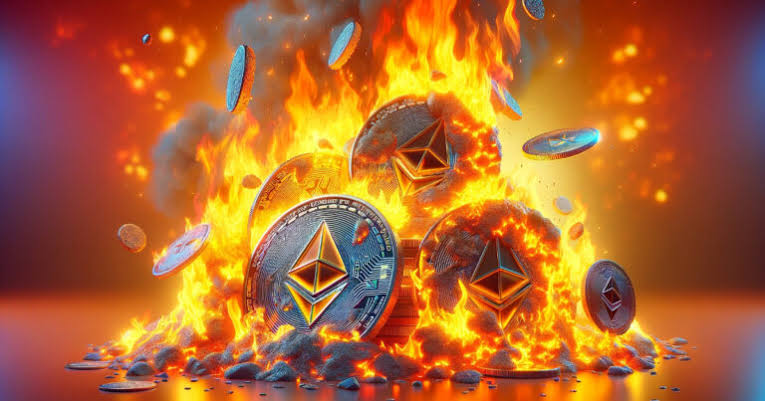Add your promotional text...
Ethereum's Surge: Understanding the 168% Increase in Burn Rate and Its Implications for Price Performance
Synopsis: Ethereum has recently seen a remarkable 168% increase in its burn rate, indicating heightened on-chain activity and potential price implications. This article explores how the deflationary pressure from the daily burning of ETH influences supply dynamics and price movements. With a significant reduction in circulating supply driven by increased network usage, the current bullish outlook for Ethereum is examined alongside historical trends of burn rate spikes preceding price rallies. As Ethereum trades at $2,617, the interplay between burn rates, network activity, and market sentiment will be crucial in forecasting its future performance.
CRYPTOCURRENCY
By Deepak Sethi
9/26/20243 min read


Ethereum has recently experienced a significant surge in its burn rate, climbing by an impressive 168% over the past week. This spike signals heightened on-chain activity and carries potential implications for the price performance of the cryptocurrency. The burn mechanism, which permanently removes a portion of Ethereum (ETH) from circulation, plays a critical role in influencing the supply dynamics and, consequently, the asset’s market valuation.
Deflationary Pressure and Its Impact
A key driver of Ethereum’s price action is the deflationary pressure created through its burning process. Every day, a substantial quantity of ETH is burned, which reduces the total supply of the cryptocurrency in circulation. Over the last seven days, Ethereum’s supply and demand dynamics have shifted significantly, with 6,098 ETH being introduced into the system while a staggering 12,250 ETH was burned. This trend points toward a net reduction in Ethereum’s circulating supply, intensifying the deflationary forces at play.
One of the primary contributors to the sharp increase in Ethereum’s burn rate is the rising activity across its network. Ethereum’s ecosystem supports a wide range of applications, such as decentralized finance (DeFi) protocols, non-fungible tokens (NFTs), and various decentralized applications (dApps). These activities incur gas fees, which are paid in ETH and subsequently burned, contributing to the overall reduction in the cryptocurrency’s supply. As a result, increased usage across the Ethereum network directly leads to more ETH being burned.
The Role of Network Activity
Ethereum’s burn mechanism serves as a vital tool in managing the cryptocurrency’s inflation. As network activity surges, more ETH is burned, leading to a reduced supply of the asset. This deflationary effect is crucial in maintaining the balance between supply and demand, which in turn influences Ethereum’s price movements. The correlation between increased network activity and higher burn rates underscores the importance of Ethereum’s utility in determining its value.
Historically, significant spikes in Ethereum’s burn rate have been followed by price rallies. For example, similar surges in the burn rate in January and October of 2023 preceded notable upward movements in the price of ETH. In these instances, the reduction in supply, coupled with steady or rising demand, led to favorable price action. This trend highlights the importance of tracking burn rate fluctuations as a potential indicator of future price momentum.
Price Performance and Market Outlook
At present, Ethereum is trading at $2,617, reflecting signs of recovery after recent market volatility. The cryptocurrency appears to be approaching key resistance levels, suggesting the possibility of further upward movement in the near term. As the burn rate continues to rise, market participants are closely monitoring Ethereum’s price behavior, with many expecting the asset to benefit from the ongoing reduction in supply.
While the current outlook for Ethereum is bullish, it is important to remember that the burn rate alone is not a guaranteed predictor of long-term price increases. Other factors, such as overall network activity, market sentiment, and macroeconomic conditions, also play significant roles in determining the cryptocurrency’s price trajectory. Nevertheless, a high burn rate is a reliable indicator of Ethereum’s present utility and demand within its ecosystem.
In summary, Ethereum’s recent 168% increase in its burn rate points to robust network activity and a potential shift in market dynamics. The deflationary pressure resulting from Ethereum’s burn mechanism has historically led to price rallies, particularly when combined with stable or rising demand. As Ethereum’s circulating supply continues to shrink, market participants should remain vigilant, paying close attention to both the burn rate and other key factors that influence price movements.
Although a high burn rate is not an infallible predictor of future gains, it serves as a strong signal of the network’s health and overall demand. With Ethereum currently showing signs of recovery, the coming weeks could see further price appreciation, particularly if the burn rate remains elevated. However, it is essential to consider all market variables before making investment decisions, as price movements are influenced by a wide range of factors beyond just the burn rate.
